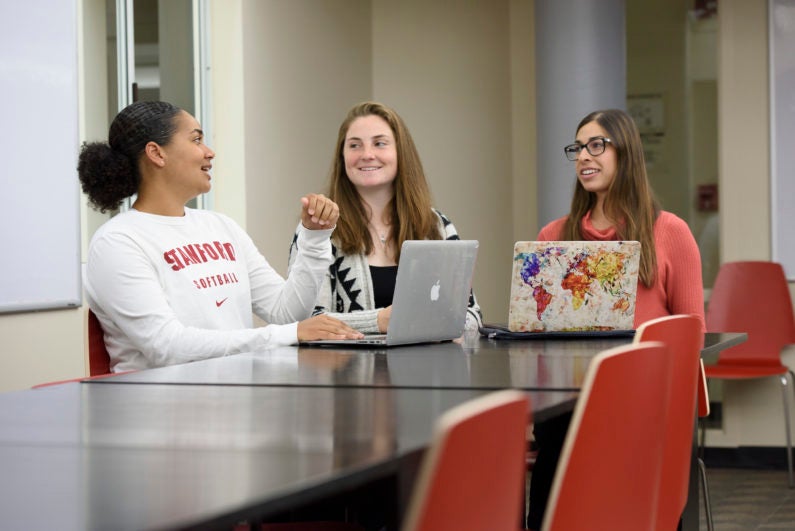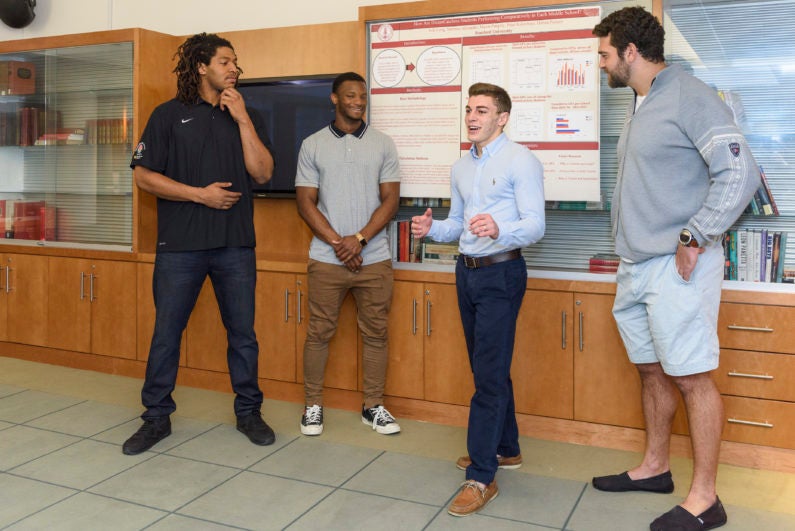Stanford students put newfound research skills to work on behalf of an organization that tutors schoolchildren
Students enrolled in Communication Research Methods designed small-scale research studies for a local nonprofit organization that offers one-on-one tutoring to children.
This year, Jennifer Pan, an assistant professor of communication, transformed her classroom of undergraduates in Communication Research Methods into a kind of “pop-up” social science research firm working for a nonprofit organization that provides one-on-one tutoring to middle-school children.

Haley Snyder, Arden Pettit, and Rebecca Mehra discuss their project for the Communication Research Methods class. (Image credit: L.A. Cicero)
Instead of posing hypothetical problems for students to solve, Pan invited students to consider real-world problems by designing small-scale research studies for the organization, known as DreamCatchers.
“Doing research in a real setting, where you encounter challenges and obstacles, reinforces learning,” she said.
DreamCatchers, which is based in Palo Alto, pairs low-income children with personal tutors for the school year. Under the program, children receive customized support from their tutors – Stanford students and local high school students who serve as role models and as academic cheerleaders – in vibrant after-school classrooms.
Mark Ibanez, ’18, one of 60 Stanford students enrolled in the course, said it was “truly incredible” to apply the skills he was learning to an organization’s real-world needs.
“To know that we are learning practical and essential research techniques in the hope of impacting the ways that DreamCatchers conducts its tutoring programs in the future makes all the tedious work worth it,” Ibanez said.

Peter Kalambayi, left, Terrence Alexander, Mason Pengilly, and Erik Lorig practice the presentation they would make in the Communication Research Methods class. (Image credit: L.A. Cicero)
Ashley Westhem, ’17, who is pursuing a master’s degree in communication, said it was gratifying to work on behalf of DreamCatchers while learning key research methods.
“It was rewarding and motivating to know that our projects are not simply for a grade but can have tangible results on an organization,” she said. “My team and I want to give back, since we feel so thankful to be at Stanford. This class allows us to do just that.”
Olivia Popp who took the course during her first year at Stanford, said the course got her thinking about how to best design her research projects to yield tangible results that could be implemented in the future.
“Plus, it feels like good exposure to see how researchers and organizations can ultimately work in tandem to enact change in the world around us,” Popp said.
Communication Research Methods was one of more than 160 Cardinal Courses offered this year. Cardinal Courses, which integrate rigorous coursework with real-world service experience, are a singular feature of a Stanford undergraduate education.
Learning by doing
At the start of the course, Pan introduced students to their “client” – Miguel Fittoria, program director of DreamCatchers – who sought their expertise to figure out what was working already, as well has how the organization could improve its program to better serve children.
“Like many nonprofit organizations, DreamCatchers had been collecting data about its program and impact, but needed help analyzing it,” Pan said. “That’s where we came in.”
Pan’s students were excited about their roles as fledgling social scientists from the start.
“When I looked at their assignments, I saw that students not only thought about the challenges facing the organization and what was important for DreamCatchers to understand, but they were also applying what they were learning in class,” Pan said.
During the first lab, the students formulated research questions, generated testable hypotheses, and provided conceptual and operational definitions for their hypotheses.
“Pretend you could do everything from a lab experiment with DreamCatchers students, to a student or tutor survey, to getting student data from the Palo Alto Unified School District, or any other ethical and feasible study you can imagine,” Pan told her students. “While your research will be constrained once you see the data available from DreamCatchers, for the final project you will be asked to design an ideal study to answer your research questions.”
Tackling research questions
The students, organized in 13 teams, pursued a variety of research questions.
After learning that children enrolled in the DreamCatchers program often didn’t know how to perform well in school, Popp and her team decided to investigate whether there was a connection between student enthusiasm for education and good grades.
“We thought it might be interesting to explore whether encouraging students to be more enthusiastic about education might instigate something inside them to speak more in class and become more proactive in their own learning,” Popp said.
Ibanez and his team designed a study to test the hypothesis that the lower the parental employment status, the more influence DreamCatchers had on student academic performance.
“By answering that question, we hope that DreamCatchers would be better equipped to understand its impact on students from different family structures, as well as the needs of these students, and to visualize any academic disparity gaps across different parental employment statuses that DreamCatchers is or is not closing,” Ibanez said.
After hearing that DreamCatchers couldn’t keep up with the demand of middle-school students who want to take part in the program, Westhem and her team decided to conduct research that would help the organization serve more children.
“If we can prove that there are other metrics to use to judge the future success of students aside from grades, GPAs and test scores, DreamCatchers can ‘graduate’ students from their program sooner and more frequently, and make room for students who need the program more,” Westhem said.
At the end of the course, the teams summarized their work in scientific posters. In addition to the traditional elements of a poster – abstract, introduction, methods and data, results and discussion – the students described how they would design a future survey or experiment to better answer their research questions.
“We presented the posters to DreamCatchers,” Pan said. “The idea is that next year, DreamCatchers would implement some of the research plans.”
